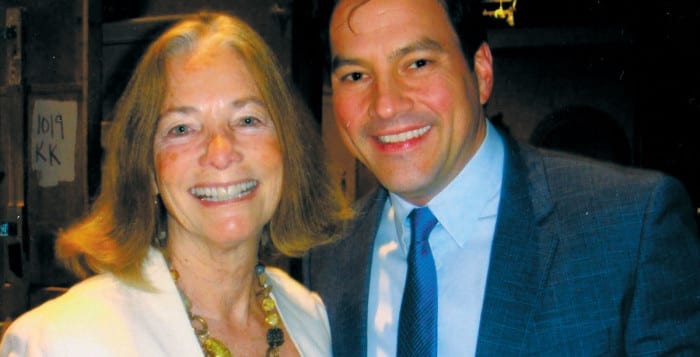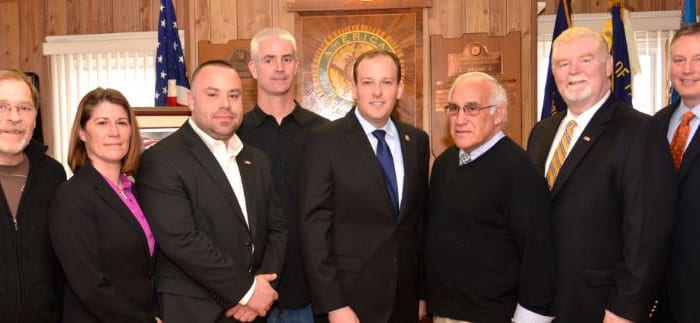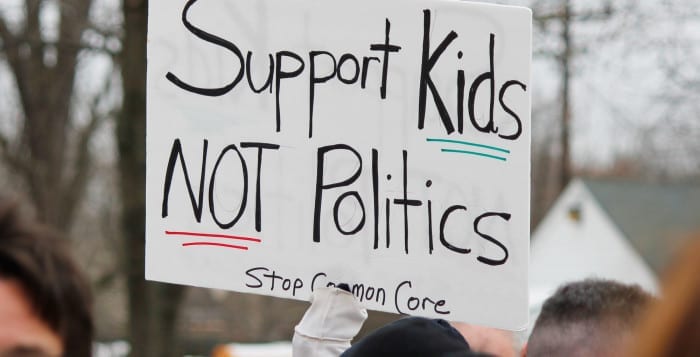By Kerri Glynn
“5 … 4 … 3 …”
Time to move. Walk through the beaded curtain. Pause by the table. Chat with the bearded man. Exit downstage.
But wait! What’s my motivation? Who is this man? My husband? Lover? Business partner? What was I doing here in Las Vegas — so far from Port Charles?
I was a cast member on “General Hospital.” Okay. I was an extra. But I’d dreamt about this for 39 years and it was finally happening.
Rewind to November 17, 1981. I was one of 30 million people who watched the wedding of “General Hospital’s” Luke and Laura. I was directing a high school production of “Barefoot in the Park” and my stage manager brought in a small, portable TV — the kind with rabbit ears — and we halted our rehearsal to watch the nuptials. It was the highest rated hour in American soap opera history, and the super couple ended up on the cover of People and Newsweek magazines. They were credited with taking daytime out of the closet so people were no longer ashamed to say “I watch a soap opera.”
I was never ashamed.
I’ve been watching “General Hospital” on and off since 1967. Sometimes I didn’t see it for weeks, sometimes months, even years. But I’d catch up on holidays and summer vacations, and it was pretty easy to do. So many of the same characters remained; so many story lines were recapped script after script. And there was always the Soap Opera Digest magazine to grab and peruse while waiting for my turn at the supermarket counter.
As an English teacher and Vassar graduate, many of my colleagues were shocked to hear me admit my devotion to the show. Why, I wondered? What did Charles Dickens write that couldn’t be classified as soap opera? For that matter, how different is “Downtown Abbey”? The Crawleys just have a bigger house, better clothes and cooler accents.
But I never imagined the day would come when I would join the cast of my favorite show, and it was the star of that early production of “Barefoot in the Park” who made it happen. My former student is now a writer/actor and good friend of the executive producer of “General Hospital.” When he heard I was visiting LA, he asked if I could be an extra on the soap. The answer was yes and my adventure began.
A week before filming, I was contacted by the casting coordinator. Would I be a patient being wheeled down the hospital hall? Or a barfly at the Metrocourt Hotel, swilling a dirty martini? When I was told I’d play a guest at an upscale Las Vegas hotel, I was intrigued. A Las Vegas hotel? “General Hospital” takes place in Port Charles, New York. Which characters would be visiting Las Vegas? And what would they be doing there?
I received a list of instructions — everything from a confidentiality clause (in other words, I couldn’t share any knowledge of the plot before the episode was aired) to my wardrobe instructions. Since I don’t tweet and still carry a flip phone, the first instruction was easy to follow. The second was a little harder, but it earned me a $10 wardrobe allowance.
I was due at Prospect Studios in Los Angeles at 2 in the afternoon. Most of the cast had arrived at 7 that morning and wouldn’t leave till 7 that night. After getting my ID badge from the guard, I proceeded to the stage manager’s desk to sign in. Then on to the Business Office with my passport to fill out a W-4. I was going to get paid for this? How cool was that!
The studio has seven sound stages and “Grey’s Anatomy” is another of the shows filmed there. The space was huge and held multiple sets. I could walk past the hospital chapel and the Floating Rib to the Quartermaine mansion. I recognized each one.
The other four extras were sitting in the Green Room where we’d wait for our call. Our names were Hotel Staffer and Guests 1-4. The others were professional actors, struggling to book commercials and dreaming of their big breaks. One of them had punched Luke out in an earlier episode, another had sat at Laura’s table at the Nutcracker Ball. Who would I be acting with? Fifty three scenes were being shot that day, and the characters included Scottie, Franco, Nina, Dante — you’ll recognize all these names if you, too, watch the show. (But don’t admit it.)
Then HE walked in — Tyler Christopher, “Prince Nikolas Cassadine,” the character I’d named my favorite cat after. He’s been on the show for 20 years and I’d long had a crush on him. There he was in the flesh … holding his script and getting a cup of coffee with the rest of us. I got up the courage to do it — to introduce myself and tell him about the cat and he laughed. We talked about his long lost love, “Emily” and how I longed to have her dug up and returned to him. It could happen. Characters have been revived even after they had been shot, drowned, frozen and had their major organs given to other characters. He was joined by his co-star, Rebecca Budig, aka “Hayden,” but formerly “Greenlee” from “All My Children.” She was just as nice and welcoming as Tyler. They promised me a picture after the taping.
So, it was sit and wait, and watch the monitors as other scenes were being filmed in the building. There were two directors working that day and multiple cast members. My 10 scenes would be set in the Las Vegas hotel where Nikolas and Hayden were getting married. I couldn’t have been more excited than if I’d won that Mega Powerball.
So many things surprised me that day — the size of the crew, the speed at which each scene was taped, the actors’ voices that seemed to whisper on set but be clear as a bell on video. People may mock soap opera scripts and actors, but everyone was a consummate professional. An average television series has 13 to 22 episodes, some a half hour, some a whole hour. “General Hospital” shoots about 286 one-hour episodes a year.
When my scene was called, the primary actors walked on set with their scripts in hand. The director told them where to stand and when to move. Then two of us extras were brought in. We were given our instructions. On the count of 3, we entered through the curtain. Chatted. Left. I’ll nail it next time, I thought. I’ll create my own back story. I’ll look for the cameras. I’ll …
“Taping scene 39.”
What?
“5, 4, 3 …”
We enter again. We chat. We leave.
“That’s a take.”
Four times I was called to the set. I sat and pretended to check my iPhone. I crossed the lobby with a blond girl. My daughter? Four hours later, we were thanked and asked to leave. The others did. But Rebecca Budig (bless her heart) remembered the promise and found “Nikolas” for my picture. She even took it.
As I left the studio, I looked at all the photos on the walls — pictures of cast members. The original cast — Dr. Hardy and Nurse Jessie Brewer, the Quartermaine family … and Luke and Laura’s wedding portrait. My life had come full circle. The boy I was directing would grow into a man who made my dream come true. Three weeks later I got to see myself on TV — on my favorite show — with my favorite soap star. And two weeks after that, I received a check in the mail for $260. I’d been paid for two days work because my fourth scene appeared the following day.
I’m not ashamed to say it. I LOVE that show.
Kerri Glynn is a retired English teacher who has lived in Setauket with her husband Tim for many years. Today she is a writer and tutor as well as the director of education for the Frank Melville Memorial Park.















